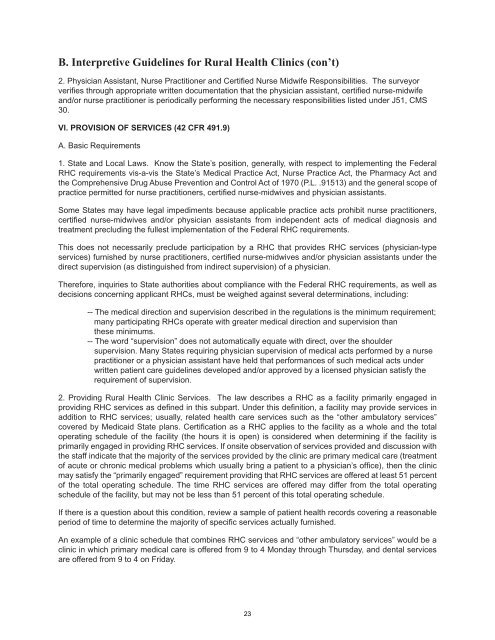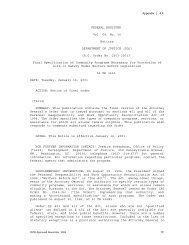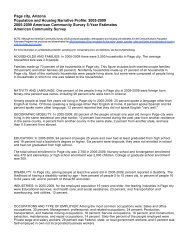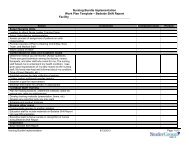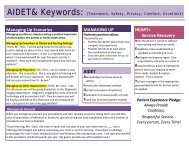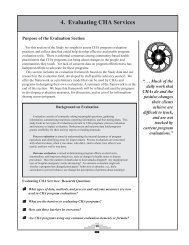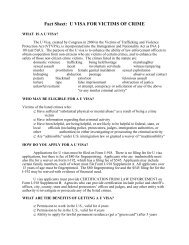Arizona Rural Health Clinic Designation Manual - Arizona Center for ...
Arizona Rural Health Clinic Designation Manual - Arizona Center for ...
Arizona Rural Health Clinic Designation Manual - Arizona Center for ...
You also want an ePaper? Increase the reach of your titles
YUMPU automatically turns print PDFs into web optimized ePapers that Google loves.
B. Interpretive Guidelines <strong>for</strong> <strong>Rural</strong> <strong>Health</strong> <strong>Clinic</strong>s (con’t)<br />
2. Physician Assistant, Nurse Practitioner and Certifi ed Nurse Midwife Responsibilities. The surveyor<br />
verifi es through appropriate written documentation that the physician assistant, certifi ed nurse-midwife<br />
and/or nurse practitioner is periodically per<strong>for</strong>ming the necessary responsibilities listed under J51, CMS<br />
30.<br />
VI. PROVISION OF SERVICES (42 CFR 491.9)<br />
A. Basic Requirements<br />
1. State and Local Laws. Know the State’s position, generally, with respect to implementing the Federal<br />
RHC requirements vis-a-vis the State’s Medical Practice Act, Nurse Practice Act, the Pharmacy Act and<br />
the Comprehensive Drug Abuse Prevention and Control Act of 1970 (P.L. .91513) and the general scope of<br />
practice permitted <strong>for</strong> nurse practitioners, certifi ed nurse-midwives and physician assistants.<br />
Some States may have legal impediments because applicable practice acts prohibit nurse practitioners,<br />
certifi ed nurse-midwives and/or physician assistants from independent acts of medical diagnosis and<br />
treatment precluding the fullest implementation of the Federal RHC requirements.<br />
This does not necessarily preclude participation by a RHC that provides RHC services (physician-type<br />
services) furnished by nurse practitioners, certifi ed nurse-midwives and/or physician assistants under the<br />
direct supervision (as distinguished from indirect supervision) of a physician.<br />
There<strong>for</strong>e, inquiries to State authorities about compliance with the Federal RHC requirements, as well as<br />
decisions concerning applicant RHCs, must be weighed against several determinations, including:<br />
-- The medical direction and supervision described in the regulations is the minimum requirement;<br />
many participating RHCs operate with greater medical direction and supervision than<br />
these minimums.<br />
-- The word “supervision” does not automatically equate with direct, over the shoulder<br />
supervision. Many States requiring physician supervision of medical acts per<strong>for</strong>med by a nurse<br />
practitioner or a physician assistant have held that per<strong>for</strong>mances of such medical acts under<br />
written patient care guidelines developed and/or approved by a licensed physician satisfy the<br />
requirement of supervision.<br />
2. Providing <strong>Rural</strong> <strong>Health</strong> <strong>Clinic</strong> Services. The law describes a RHC as a facility primarily engaged in<br />
providing RHC services as defi ned in this subpart. Under this defi nition, a facility may provide services in<br />
addition to RHC services; usually, related health care services such as the “other ambulatory services”<br />
covered by Medicaid State plans. Certifi cation as a RHC applies to the facility as a whole and the total<br />
operating schedule of the facility (the hours it is open) is considered when determining if the facility is<br />
primarily engaged in providing RHC services. If onsite observation of services provided and discussion with<br />
the staff indicate that the majority of the services provided by the clinic are primary medical care (treatment<br />
of acute or chronic medical problems which usually bring a patient to a physician’s offi ce), then the clinic<br />
may satisfy the “primarily engaged” requirement providing that RHC services are offered at least 51 percent<br />
of the total operating schedule. The time RHC services are offered may differ from the total operating<br />
schedule of the facility, but may not be less than 51 percent of this total operating schedule.<br />
If there is a question about this condition, review a sample of patient health records covering a reasonable<br />
period of time to determine the majority of specifi c services actually furnished.<br />
An example of a clinic schedule that combines RHC services and “other ambulatory services” would be a<br />
clinic in which primary medical care is offered from 9 to 4 Monday through Thursday, and dental services<br />
are offered from 9 to 4 on Friday.<br />
23


